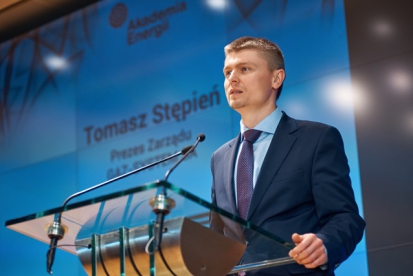Poland Reports Record 2017 Flows
Polish state network Gaz-System said that 2017 was a record year for gas transmission. In a March 2 statement, released in English this week, it said its transmission volume reached 19.7bn m3 (221.9 TWh), almost 9% higher than in 2016, which it said “confirms the increased demand for natural gas in Poland.”
Gaz-System chief Tomasz Stepien (pictured below) picked up on the higher transmission volume to argue the case for further investment: “We believe that the construction of the Baltic Pipe will strengthen this trend even further by enhancing the stability and security of supply. The development potential of the natural gas market in Poland is very high.” He added that gas can help Poland combat air pollution and smog, which he said was a “serious problem in large urban areas.”
Flows from Poland to Ukraine were strongly up in 2016-17 owing to Ukrainian state Naftogaz’s halt on Russian imports in those years. Such trade remains important to Kiev.
Flows through the Yamal transit line, which physically flows Russian gas via Belarus/Poland to Germany, though, are excluded from the calculations: these decreased slightly to 34.6bn m3 in 2017, from 34.78bn m3 in 2016 according to Gaz-System's data.
Gaz-System’s national 2018-27 Ten Year Plan foresees Polish gas demand continuing to grow, indeed it forecasts that gas demand in its power generation sector will double to 2.7bn m3 in 2027, from 1.3bn m3 last year, although adds that the actual figure will depend on how many plants are built. More than four-fifths of Poland's existing power production is generated from coal, and new 'super-critical' coal-fired plants are under construction.
Under its 2015-2025 investment scheme, Gaz-System plans to build over 2,000 km of new gas lines in western, southern and eastern Poland, plus interconnectors with Lithuania, Slovakia and the Czech Republic, a 50% capacity increase in its existing Swinoujscie LNG terminal, and potentially a second terminal at Gdansk (a floating one, located in the bay). Critics say much of this is unnecessary and will burden or deter new entrants to the market – who might supply cheaper gas from Germany – with too many costs.
Gaz System’s total transmission network reached 11,059 km at end-2017, up 6% year on year; its working gas storage capacity remained 3bn m3 and includes capacity reserved for Gaz-System itself.
While more gas may be flowing in and across Poland, imports from Gazprom are trending lower. The state-run leading gas importer PGNiG said last week it bought about 1.5bn m3 less gas from Russia in 2017 than it did in 2015.

Gaz-System's president of the management board Tomasz Stepien (Photo credit: the company)



